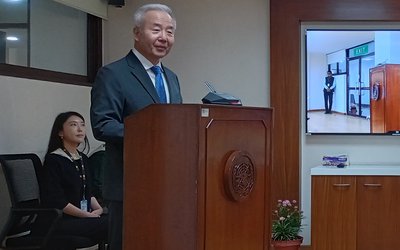More on National





With the announcement of the results of the School Leaving Certificate exams, advertisements of various higher secondary schools offering courses for the new graduates are flooding the market. To lure the students, higher secondary schools are making every bit of publicity effort.
With attractive hoarding boards in various nooks and corners of the city and floods of advertisements of various schools in newspapers, radio and television channels, private investors are now selling education as a good venture to maximize the profit. Out of 495,998 students who appeared in the SLC, 208,235 or 47.16 percent students passed this year.
More than 3000 higher secondary education institutions are now competing to lure the over 200,000 students. There are three different types of higher secondary schools in the country. Although higher secondary education is a part of the school education system in other parts of the world, this is still regarded as higher education in Nepal. This is the reason Higher Secondary Education Board issued permission to three different institutions to run +2 education.
Along with high schools, there are +2 colleges. Some university affiliated colleges are also running +2 systems. Mostly 10+2 higher secondary schools are commercializing the education. Out of 3000, a large numbers of higher secondary schools are community schools attached with high schools. However, students prefer get admission to colleges or +2 schools.
“The government has already prepared a bill that will change the present education system making up to 12 as school education,” said Kishor Thapa, secretary of Ministry of Education. “This is the only way to end the existing bad practices in higher education.”
Although the government has floated the idea to cancel the SLC board by allowing the higher secondary education board to conduct the final exams of school education, the idea is yet to materialize. In the context of the growing influence by private investors in the +2 education and increasing hobnobbing of politicians and private investors, changing the present education system will take a time.
“We are persuading the government to make +2 a part of high schools. Private and boarding schools are ready to support the government to improve the quality of school education,” said Dr. Baburam Pokharel, founder principle of VS Niketan School and president of Private and Boarding Schools Association of Nepal (PABSON).
Although the thrust of education should be to impart quality education to the students and produce manpower which can meet the requirements of the country, the situation is different here as most of the private +2 schools in urban areas are concerned with business. Luring students through advertisement, these schools charged huge amounts of money from the students.
Education experts argue that Nepal’s higher secondary education turns merely into a money making venture. Those who invested the money have already made huge profits by attracting others. “Some school owners are making +2 education as a noodle producing factory,” said Krishna Kanta Parajuli, chairman of CANVAS international school.
Private Investment
Private investment is not bad at all given strong regulatory authority with monitoring capability. Thanks to private investment, the quality of education in Nepal has improved a lot including stopping Nepalese students going abroad for +2 education. “ After introduction of higher secondary education system in Nepal, we have been able to change the mentality of parents who used to send their children in foreign countries after completion of SLC,” said Dr. Pokharel.
Higher secondary school education completely relies on the private sector investment and the present trend of commercialization is the outcome of this trend. Although many community schools are also running +2, they too do not receive any subsidy from the Ministry of Education. This is the reason the qualities of education in community schools and private schools are different. Had the government created a strong regulatory authority and provided some sort of subsidy to recruit highly qualified teachers, the present scenario would have been different.
Following the publication of results of SLC, Nepal’s media is flooded with the advertisements of various private Higher Secondary Schools with commitment to offer the quality and competitive education to the students. In the race of marketing, community schools are nowhere.
“10+2 is a hundred percent private sector is investment. Education should not be commercialized as today. Government does not have regulatory authority. Had the regulatory authority set up norms for education including fees, the situation would have been different,” said Dr. Tirtha Khaniya, former vice chairman of the Higher Secondary Education Board and the member of the National Planning Commission. “Commercialization should be stopped in 10+2 and one must preserve reverence to the education system.”
When Nepali Congress led government under Education Minister Govinda Raj Joshi introduced 10+2 as a replacement for redundant proficiency certificate level from Tribhuwan University, he fought tooth and nail with communist factions and teachers associated with left front. His team of higher secondary education reforms led by Dr. Tirtha Khaniya survived several physical assaults from students wings and leftist teachers. Ironically, now leftists or their sympathizers, control over 70 percent of higher education of institutions in Nepal. And those, who opposed this system were charging Nepali Congress with selling education to private company, are now the major beneficiaries.
“UML and UCPN-Maoist sympathizers have virtually destroyed the revered education being a partyto commercial interests. Mant attached the name of their leaders in commercial purposes tying the institutions with their late comrades like Pushpa Lal Memorial, Manmohan Memorial, Madan Bhandari Memorial. Even former minister Devi Prasad Ojha, who held the education ministry during the CPN-UML rule, is now running Morgan, a highly commercial higher secondary school.
Tragedy of education
At a time when higher secondary schools are competing with each other to pull the students, the suicide of 12 girls after failing SLC exams has sent a shock wave. With a hype in the media about passing SLC as if that was the greatest achievement, psychologically everybody sees SLC certificate as a panacea for the beginning of new life.
Although the failed percentage in bachelor’s level and higher secondary education level is much higher than in SLC, there are rare cases of suicide at these levels,”said educationist Dr. Khaniya.
Psychologist Dr Ganga Pathak blamed their demanding parents for the suicides of these girls. “The girls may have committed suicide due to pressure, and the accompanying guilt, of not being able to meet the expectations of their parents,” Dr Pathak said.
She also said that giving undue importance to SLC piles up pressure on the students. “The students would have appeared in hundreds of exams and passed them before sitting for SLC. The fear of SLC, however, takes over and they cannot perform well in the exams,” she explained.
Nearly more than one thirds of the higher secondary programs are not attached with secondary schools. This affects a lot in the development of a psychology that higher secondary education is also a part of school education.
The programs of 10+2’s that are affiliated by the Higher Secondary Education Board are much more than that of community based T.U. affiliated campuses.
Mostly T.U. campuses are limited only in the cities and headquarters of districts whereas higher education programs are distributed not only in the urban areas but also in the rural areas and the villages. These types of programs are very useful in removing the imbalance of educational opportunities. But before starting these programs the burden of infrastructures.
“There are 3383 higher secondary schools. In 2068/069 alone, 88 school received permission,” said Dr. Hem Kumar Misra, Vice Chairman, Higher Secondary Education Board. “We are concerned with commercialization,” said Mishra. “It is said that education is a lifelong process, but the basic education that one gets during the formative years definitely contributes to the shaping of one's future and outlook. This is where the school and high school education assumes importance.”
Following this outcome, Government of Nepal decided to introduce the Higher Secondary Education Act, which came into effect in 1989 A.D. Later, as stipulated in the Act, the Higher Secondary Education assembly was constituted under the chairmanship of the Minister of Education.
Subsequently Higher Secondary Education Board (HSEB) was established in 1989 under the Higher Secondary Education Act. The board is involved in running the 10 + 2 system in the country. Nepal National Commission of Education 1992 recommended the importance of the 10 + 2 structure in the education system and viewed it as the first step towards specialization.
Incorporating extra two years in school education was a change in the existing educational structure aiming at meeting the middle level manpower and imparting necessary knowledge and skills to the students pursuing further education.
The higher secondary education in Nepal, is nothing more than the result of globalization, a need to come in terms with the global markets when the world is turning into a global village, and the countries, borderless.





